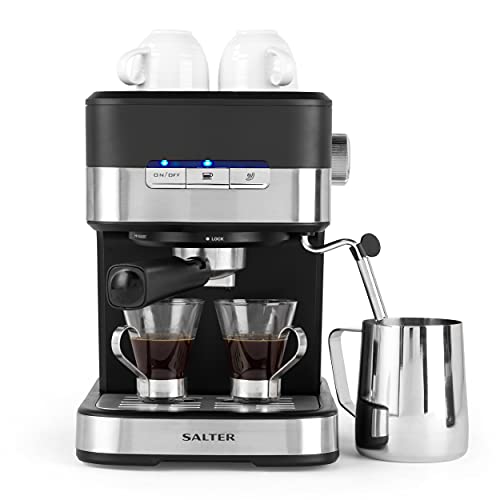How Does Machine Espresso Work?
Machine espresso utilizes precise pressure and mind-blowing filter technology to make the delicious coffee we enjoy. What exactly is it?
Espresso is made by pushing hot water under high pressure through finely ground coffee. The process is similar to making drip coffee, but the major difference is in the pressure.
The Group Head
As the name suggests, the group head is the place you place your portafilter when brewing espresso. It disperses water into the portafilter, and regulates the pressure of the extraction. There are several different types of group head each with its own advantages and disadvantages. Some are designed for stability of temperature while others are built to handle pre-infusion. espresso coffee machine are made to control the lever. Some include a mix of features, such as the E61 one, which is the standard choice for many baristas due to its ability to provide multiple benefits in one package.
As you can see in the above photo the group head comes with many notches in which you can place your portafilter and twist it by hand to lock it in. There is also a gasket made of rubber which is located inside the notches to help create an airtight seal when you insert your portafilter into the machine. The notches permit precise placement of the portafilter. This is crucial for an accurate extraction.
Apart from allowing you easily insert your portafilter, the group head is responsible to maintain an even temperature. It does this by cycling hot water through the brew basket and around the portafilter to ensure that it's always at the correct temperature for extraction. This is crucial, since just a few degrees could be the difference between a good and great espresso.
The Pump

Contrary to manual piston machines which use a lever to pressurize water, rotating espresso machines rely upon motorized pumps that provide the nine atmospheric bars of pressure that are required to extract espresso. The pressure is built by pumping water through a heat exchanger and then through the ground coffee.
Pumps are typically more affordable and last longer than piston-driven machines. However, both types of machines can degrade because of frequent use and inadequate cleaning. They also increase the complexity of mechanical systems which can result in a high price tag on even the most basic models.
Some espresso machines do away with the pump completely and instead make use of steam pressure to make espresso. The drawback of this is that the boiler that produces steam also increases the temperature of water to the point of boiling, which can lead to excessive extraction. Additionally, these machines frequently have to restore their pressure between cups, which requires time and energy.
Many espresso machines make use of the rotary or vibration pump, with a vibration model using a rotating disc to create the pressure and the rotary model pushing hot water through the grounds under high speed. Both machines can make great espresso, but rotary machines are quieter, more durable and less likely to fail.
The Boiler
The boiler will heat the water to the right temperature for extraction. The resulting steam is then transferred to the portafilter which holds the ground espresso coffee and gets funnelled down into the cup. In this process, the steam causes pressure to push through the grounds of the coffee. This results in a whipped-up the top of the espresso. This is the hallmark of a great espresso.
There are three types of espresso makers. They differ in the type of pump they employ and how hot the espresso is. There are also different ways that the brew can be controlled and the size of the cup the machine is capable of making.
The first espresso machines were steam type. The first espresso machines were steam types. The coffee tasted bitter and burned. This is why the Milanese producers Luigi Bezzerra and Desiderio Pavoni developed the modern espresso machine.
The most commonly used espresso machine is a semiautomatic one with an electric pump. This is what people envision when they think of an espresso maker. With a semi-automatic espresso machine, you need to grind the beans and then tamp them yourself but the pump controls the flow of water and pressure. This is a great solution that combines human control with mechanised reliability.
The Filter
Typically, espresso machines employ filters that separate the grounds of coffee when they pass through the hot water. The filter is also an essential component of the machine's temperature control, since it stops overheating.
It also helps with flavor, since a filter allows for a longer bloom phase. This helps the beans release their flavors and provides an opportunity for better extraction.
It is important to remember that even the most efficient filter can result in a bad cup of coffee. The quality of the beans, and the extraction process are still crucial.
This is where the magic happens. It's what makes an espresso really taste good. The grouphead, sometimes called the brew head, is the place where the portafilter (the device you put the ground coffee in) is placed when you're making espresso.
In an espresso machine that is driven by steam, hot water is heated in an airtight container to produce steam, which is then pushed through the grounds under high pressure. These types of machines are typically less expensive and easier to maintain than pumps-driven models. However, they are limited in their ability to create the perfect brewing conditions as they only operate at 1-1.5 bars of pressure. However, the perfect shot requires 9-10 bar.
In recent years, espresso machines powered by compressed air-pump are becoming increasingly popular. They make use of an air compressor to force hot water through the ground, and are more mobile than electric steam-driven espresso machines.
